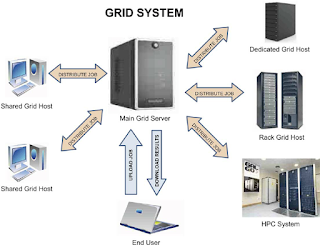Some of Definitions
- Wikipedia -
“Grid
computing is the collection of computer resources from multiple locations to
reach a common goal.”
- Oracle -
“Grid computing enables the creation of a single IT
infrastructure that can be shared by multiple business processes.”
- Microsoft -
“Grid computing is a group of
networked computers that work together as a virtual supercomputer to perform
large tasks, such as analyzing huge sets of data or weather modeling.”
Advantages from Grid Computing
- More cost-effective in the use of a certain number of computer resources.
- As a way to solve problem, that may not be solve without a large amount of computing power.
- Shows that resources from multiple computers. It can be cooperative and synergistically harnessed, and can be managed as a collaboration toward a common goal.
Disadvantages from Grid Computing
- Overly bureaucratic institutional management. It makes them reluctant to own facilities to be used together in order to gain greater benefits for the wider community.
- There are still few competent human resources in managing grid computing.
- Lack of knowledge that includes both IT technicians and non-technicians about the benefits of grid computing itself.
Some of Basic Concepts in Grid Computing
- Resources are managed and controlled locally.
- Different resources may have different policies and mechanisms, including computing resources managed by different batch systems. Different storage systems at different nodes, Different policies are entrusted to the same user on different resources on the grid.
- Dynamic nature. Resources and users can change frequently.
- A collaborative environment for e-communities.
Working Principle of Grid Computing
- Virtualization
Each resources, like computers, disks, application components, and information resources is collected together by type. Then made available to consumers, such as people or software programs. Virtualization means removing the physical connection between the provider and the consumer of resources, and preparing resources to meet the needs without the consumer knowing how his request can be served.
- Provisioning
1.
When a consumer requests resources via a virtualization layer, a specific resource behind a layer is defined to satisfy the request, and then allocated to the consumer. Provisioning as part of grid computing means that the system determines how to meet consumer need along with optimizing the running of the system as a whole.
Some Elements of Grid Computing
- Hardware
Hardware in grid computing like storage devices, processors, memory, network, and software designed to manage these hardware, such as database, storage management, system management, application serves, and operating systems. Hardware on grid computing is set locally, and different hardware has different policies and ways of working. Hardware and user grid computing is often dynamic depending on the application of the grid.
- Software
Software is a device that connects all its called middleware. Middleware itself is part of the software. The software layer that lies between the operating system and applications that serve a liaison between inter-object communication from different systems. The basic elements of a middleware are security, resource management, adata management , and information services. Examples of some middleware are Globus Toolkit, Gridbus, Microsoft's COM / DCOM, Unicore, and many other middleware examples.
- Brainware
Brainware in grid computing includes only grid holders and users. Formerly grid computing tends to be only in use by scientist for scientific interest. At the time it was the largest exposure to more science projects, such as genetic research, physics and the most famous is the SETI (Search for Extra Terrestrial Intelligence) project or the search for extraterrestrial life. This raises the perception that grid computing technology is difficult to accept among non-scientist, especially in business circles. However, now the application of grid computing has penetrated. Its use not only on science projects alone. Even recently, grid computing technology has been introduced to the entrepreneur world and received many positive responses.
Source : www.bierpinter.com
Source : www.bierpinter.com









No comments:
Post a Comment
Don't forget to write your impressions in the comments column. It is very valuable for me ^^